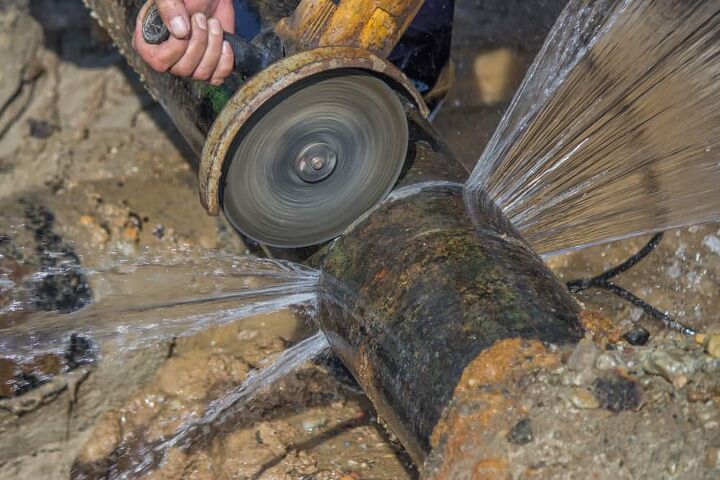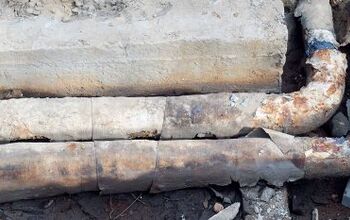How To Cut Cast Iron Pipe (6 Ways To Do It!)

For a long time, cast-iron was the primary material used for plumbing. Though some newer builds may not make use of the material any longer, there is a good chance that if you have bought a home recently, you may run into cast iron piping at some point.
When it comes time to remove that piping, there are a few options that will get the job done. All it takes is a little bit of know-how and the proper tools to get the job done. You can use a snap cutter, cold chisel, hacksaw, reciprocating saw, or even an angle grinder to get the job done. Each requires its own steps and method to get the job done properly.
Do You Need a Faucet, Fixture, or Pipe Repair or Replacement?
Get free, zero-commitment quotes from pro contractors near you.

How to Cut Cast Iron Pipes
Most homes made prior to the 21st century (and a good deal since the dawn of the millennium) will no doubt have cast iron piping running throughout the home. If you want to make a repair or changes to any of the pipes, it will likely require cutting out the section of the pipe.
Step 1: Have the Right Tools
Depending on which method that you go with, the tools required to do the job can vary. For the most part, you need something to do the cutting, though you may also require a hammer to knock the piping out, too.
For the most part, you will either need replacement blades or a hammer in addition to the method of choice. Be as prepared as you can be before cutting cast iron pipe to save yourself a lot of time and hassle in the process.
Step 2: Mark the Pipe
Before you begin cutting, you should be aware of where you are making the cuts. You can use a piece of light-colored chalk or even a crayon to designate where on the pipe that you want to make the cuts.
Simply wrap a piece of notebook or printer paper all the way around the pipe (you might need two pieces). Then, trace along the edge of the paper so that you create a clean, straight cutting line to follow along.
Step 3: Installing Pipe Supports if Necessary
If you run into any exposed horizontal runs of piping, they should be supported using pipe hangers in intervals of at least five feet. For vertical runs of pipe, they will require a riser clamp for each of the floor levels.
Unsupported cuts. If you make cuts that leave long sections of the cast iron pipe unsupported, make sure that you install riser clams or pipe hangers on both sides of that section you will be cutting out. This part is imperative so don’t skip it.
Riser clamps look like shackles and have two pieces. They clamp around the pipe through the use of bolts and they bear into the structure of the floor or into any wood blocks that may be anchored onto the wall studs inside of the stud cavities.
6 Tools and How to Use Them To Cut Cast Iron Pipe
Method 1: Using a Hacksaw
Hacksaws are the cheapest tool to use and one that the vast majority of do-it-yourself types will have around the house. That said, using a hacksaw is not necessarily the cheapest option available for cutting cast iron pipe.
The reason it isn’t necessarily the cheapest is that you will likely need multiple blades to get the job done. Using a hacksaw is fine, but it can lead to a lot of frustration in seeing blades break and needing to replace them on a regular basis. Moreover, it is also the most physically demanding and slowest method that you can use.
Method 2: Using a Cold Chisel
The other handheld method is using a cold chisel in tandem with a ball-peen hammer. The cut is generally easier, but this method takes skill and experience in order to perform it properly and successfully.
There is also another major downside to using a cold chisel: you need more space. To use the cold chisel, you will need access to the entirety of the pipe and all of the sides. Moreover, you will have to have the requisite space to use a hammer.
- Trace your line. Start by tracing your chalk or crayon line. Having a distinct, straight line to work off of simply makes cutting a bit easier and more precise.
- Make small cuts. Using a cold chisel can be more precise but it will also take quite a bit of time. To have the best results, you should make smaller cuts, moving slowly around the line as you go.
- Breakaway the pipe. Keep making small cuts all the way around the diameter of the pipe until you can tap it free using your hammer. It is best to cut all the way around the pipe to avoid any fraying or jagged edges that would need to be cleaned up.
Method 3: Using a Snap Cutter
Snap cutters are a fairly simple and effective tool to cut through cast iron pipe. The process is also fairly simple, though it can be a little physically exerting to get the job done. Still, if you are looking for a secure way to cut through cast iron, this is probably it.
- Cutting chain. Start by wrapping the cutting chain all the way around the pipe and then latching the chain. The chain will latch onto the ratcheting head and should secure fairly snugly.
- Cutting wheels. Position the cutting wheels so that they are resting on the marked line. Snug up the chain using the tension adjustment to get the proper tightness.
- Pump the ratchet arm. Use the ratchet arm to pump; this will tighten the chain each time that you crank it. The pipe should eventually snap, making a loud popping sound when it has finally broken away from the rest of the pipe.
Method 4: Using a Reciprocating Saw
Having a reciprocating saw on hand can make for a versatile tool in a number of situations. In a similar vein to the hacksaw, you may have to have a couple of extra blades on hand just in case one of them snaps during the cutting process.
- Align the blade. Start by lining up your reciprocating saw blade with the line that you marked earlier. When you are confident that you are properly lined up, start cutting at a moderate speed. You want to avoid cutting too fast because the blade can overheat and snap far more easily this way.
- Add water. Again, you want to keep the blade as cool as you can during the cutting process to prevent overheating. You can try adding cold water in small amounts as you cut to help achieve this, though it may add a little inconvenience to the process.
- Complete the cut. Finish the cut, cutting starting on one side and going to the other if you can. Using this method means getting a cleaner cut than starting from multiple directions and cutting towards the center of the pipe.
Method 5: Using an Angle Grinder
Angle grinders can be quite versatile and may even be able to perform cutting jobs in tight quarters. Like any of the other saws, it is imperative that you use caution and take proper safety precautions when using this tool.
- Protect from sparks. If you are working in tight quarters, be aware that the angle grinder will give off sparks. Make sure that you protect any of the surrounding materials from sparks as they could potentially burn or even ignite those materials.
- Cut carefully. Make sure that you keep a firm grip on your grinder. Going with a lax grip can result in some very hazardous consequences. Cut carefully along the line that you marked earlier, moving around the entire diameter of the pipe.
- Diamond blade alternative. Having a diamond blade is the best option. Diamond blades are particularly hard and make for a highly effective cutting tool. If you don’t have one, there is a chance that you can get away by using more than a single cutoff wheel in order to perform the complete cut.
Method 6: Use a Portable Bandsaw
Bandsaws are a great tool for regular cutting use. Going with smaller, lighter models means greater flexibility and versatility in cutting potential. Cast iron can be a bit tougher for some saws, but a portable bandsaw should do the trick.
The downside. There is one significant downside to using a portable bandsaw. There isn’t a whole lot of support offered by this tool, so there is a chance that your cuts may be crooked. Unless you want to deal with the cleanup efforts involved in a lopsided cut, you may want to pick something that offers a bit more in the way of support.
Do You Need a Faucet, Fixture, or Pipe Repair or Replacement?
Get free, zero-commitment quotes from pro contractors near you.

Related Questions
Can a Dremel Cut Cast Iron?
While it would be great to have a variety of saws available for any occasion, saws can get expensive. Not every do-it-yourselfer has a wide array of saws available to them. So, it only makes sense to make do with what is available.Having a Dremel with a heavy-duty cut-off wheel can make for an effective solution in a pinch. It is generally advised that a Dremel be used for softer metals, ceramics, plastics, and thin woods though it can probably work on cast iron in a pinch.The cutting disc in this instance has a hard abrasive construction that can be used for cutting through even hardened steel.

Ryan Womeldorf has more than a decade of experience writing. He loves to blog about construction, plumbing, and other home topics. Ryan also loves hockey and a lifelong Buffalo sports fan.
More by Ryan Womeldorf



























